
In the dynamic world of information technology, effective IT documentation software emerges as a linchpin for operational success and resilience.
As someone steeped in knowledge management and customer service for 10+ years, I’ve observed that robust IT documentation and IT documentation tool crucially mitigate the risks associated with knowledge silos, streamline training and onboarding, and elevate customer support outcomes.
In this blog, we will explore my top 10 best IT documentation software and tools for 2024. We will also discuss factors to consider while choosing one. Let’s start with a quick summary of my top 3.
| Best IT Documentation Software | Best For | Pricing |
| ProProfs Knowledge Base | Easily creating help sites, user manuals & private knowledge bases | Forever free plan for up to 25 articles with all premium features. Paid plan starts at $49/author/month. |
| Scribe | Auto-generated step-by-step guides | A free plan is available. Paid plan starts at $23/seat/month. |
| Document360 | Real-time search engine with faster context-sensitive results | A free plan is available. Paid plan starts at $149/project/month. |
Which Is the Best IT Documentation Software & Tools for 2024
Selecting the ideal tool for your business hinges on criteria like user-friendliness, adaptability in design, compatibility with current systems, the ability to scale alongside your business, and the availability of analytics to measure performance.
For those seeking immediate suggestions, here are three exemplary choices renowned for their proficiency in generating user manuals for various industries and businesses.
Option #1 – ProProfs Knowledge Base
ProProfs Knowledge Base’s intuitive interface and robust features, including customizable templates, real-time collaboration, and powerful search functionality, make it an ideal choice for businesses looking to enhance their IT documentation process.
The platform also seamlessly integrates various tools and advanced analytics to track user engagement and content effectiveness.
Option #2 – Scribe
Scribe specializes in automating the documentation process, enabling IT teams to create step-by-step guides and tutorials with ease quickly. Its unique feature captures processes as you perform them, generating visual, ready-to-share guides that simplify complex IT tasks.
It is perfect for organizations aiming to boost productivity by reducing the time spent on documentation and ensuring consistency across all instructional materials.
Option #3 – Document360
Document360 excels in IT documentation, offering a scalable cloud-based solution for creating a self-service knowledge base. It features an easy-to-use markdown editor, version control, and a powerful search engine, making it easier for users to quickly find the information they need.
It supports documentation for both internal team members and external users, making it versatile for a wide range of IT documentation needs.
Now, before we start with the list, let’s cover some basics about IT documentation software.
| Related blog: How to Create Online Documentation? |
What Is IT Documentation Software?
IT documentation software is a specialized tool designed to create, manage, and store documentation related to information technology systems and processes. It facilitates the organization of critical information like network documentation for configurations, software inventories, user manuals, standard operating procedures (SOPs), and service records, making them easily accessible to IT professionals and stakeholders.
The primary objective of IT documentation tools is to ensure that essential knowledge is systematically captured and organized, promoting efficiency, consistency, and continuity within IT operations.
The software usually supports various forms of documentation, including text documents, diagrams, charts, and images. It often features capabilities for collaboration, version control, and secure access management, allowing multiple users to contribute to and edit documents while maintaining the integrity and confidentiality of the information.
For example, IT documentation software that enables comprehensive FAQs for an office printer. I would feature customizable templates for FAQs, version control for tracking changes, real-time collaboration for document collaboration, and search functionality to find solutions quickly.
I would help teams in creating accessible guides on troubleshooting common printer issues, which facilitates knowledge sharing within organizations.
Top 10 IT Documentation Software & Tools for 2024
The landscape of IT documentation software continues to evolve, offering more sophisticated tools designed to streamline the creation, management, and retrieval of technical information.
Let’s explore 10 tools that offer the perfect mix of functionality and sophistication.
1. ProProfs Knowledge Base – Best for Easily Creating Help Sites, User Manuals, and Private Knowledge Bases
Having integrated ProProfs Knowledge Base into our IT support strategy, I’ve seen firsthand how effectively it can reduce internal IT tickets. Its ability to embed tooltips and pop-ups within our IT documentation has drastically reduced repetitive queries, guiding users through everyday tasks without contacting our IT department.
The platform’s detailed document performance reports have been invaluable for our documentation strategy. By analyzing which sections of our user manuals and FAQs are most accessed or lacking, we can continuously refine our content to better meet our users’ needs.
Additionally, ProProfs Knowledge Base excels in team collaboration. The ability for multiple team members to contribute to and edit documentation in real time using internal comments has fostered a more cohesive approach to our knowledge management.
What you will like:
- AI-powered, WYSIWYG editor for error-free writing
- The intuitive user interface and the wealth of user manual templates simplify the creation of comprehensive documentation
- Smart user management with custom roles to ensure appropriate access
- Seamless integration with its other in-house tools like ProProfs Help Desk and ProProfs Live Chat
- Version control to manage multiple versions based on product or documentation
What you may not like:
- The 15-day trial period may be short for thoroughly evaluating all features, especially for larger teams or more complex documentation needs
- While the freemium plan is generous for small projects, some users might find the limit of 25 articles restrictive as their documentation needs grow
Pricing:
Forever free plan for up to 25 articles with all premium features. Paid plan starts at $49/author/month.
Read More: Best Technical Documentation Examples
2. Scribe – Best for Auto-Generated Step-By-Step Guides
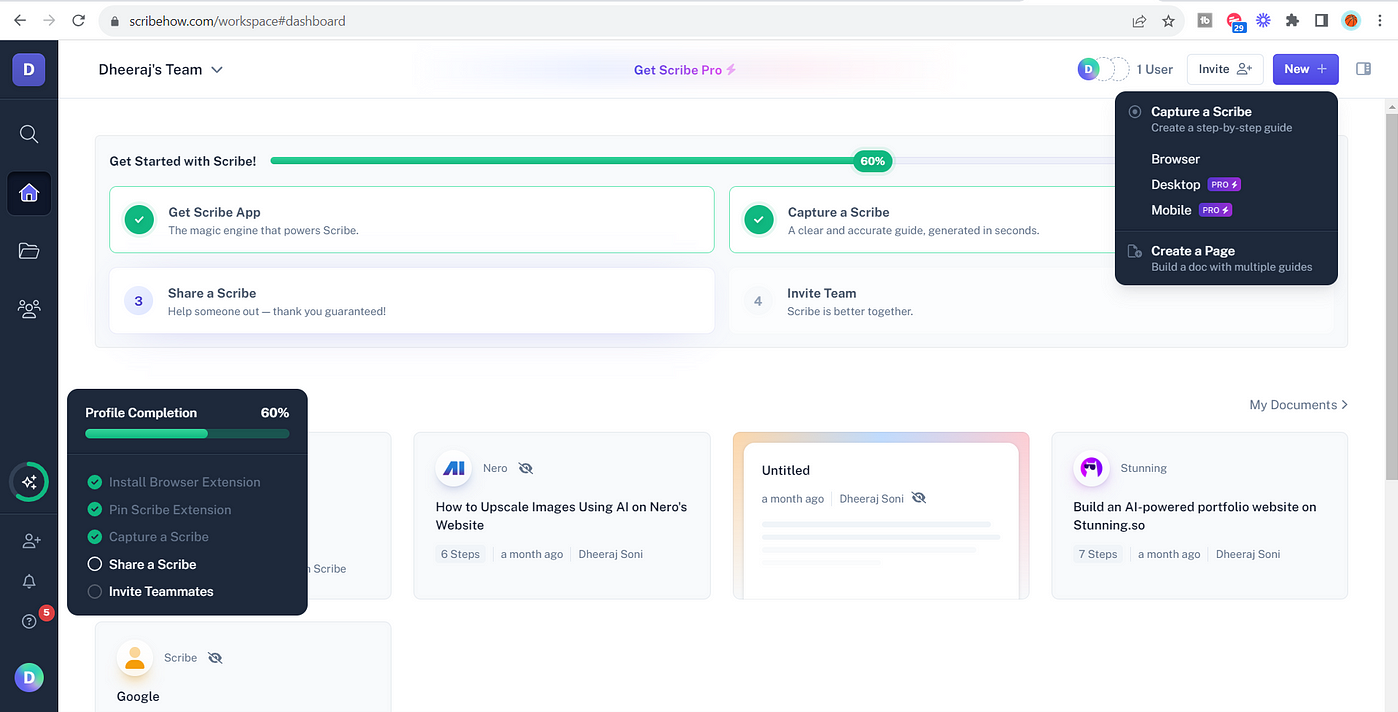
I liked Scribe for its auto-generation feature, which captures every step of a process as we perform it, producing clear, concise step-by-step guides complete with screenshots. This automation saves us considerable time and effort, particularly for documenting complex IT procedures.
The tool’s collaborative features allowed us to share knowledge and expertise within the team easily. We could quickly update guides to reflect new best practices or software updates, ensuring our documentation remains current and useful.
What makes Scribe stand out further is its integration capabilities. Being able to embed these guides directly into your internal knowledge base or share them through our communication platforms ensures that relevant information is readily accessible to everyone who needs it.
What you will like:
- Automatic capture of steps as you perform tasks, significantly reducing manual documentation time
- Easy integration into various platforms for a unified documentation repository
- Customization options for guides to match specific documentation standards
What you may not like:
- Automated capture might miss nuances of more complex tasks that require in-depth explanation
- Dependency on the user performing the task accurately for the first capture
Pricing:
A free plan is available. Paid plan starts at $23/seat/month.
Read More: 10 Best Technical Documentation Software & Tools
3. Document360 – Best for Faster Context-Sensitive Results
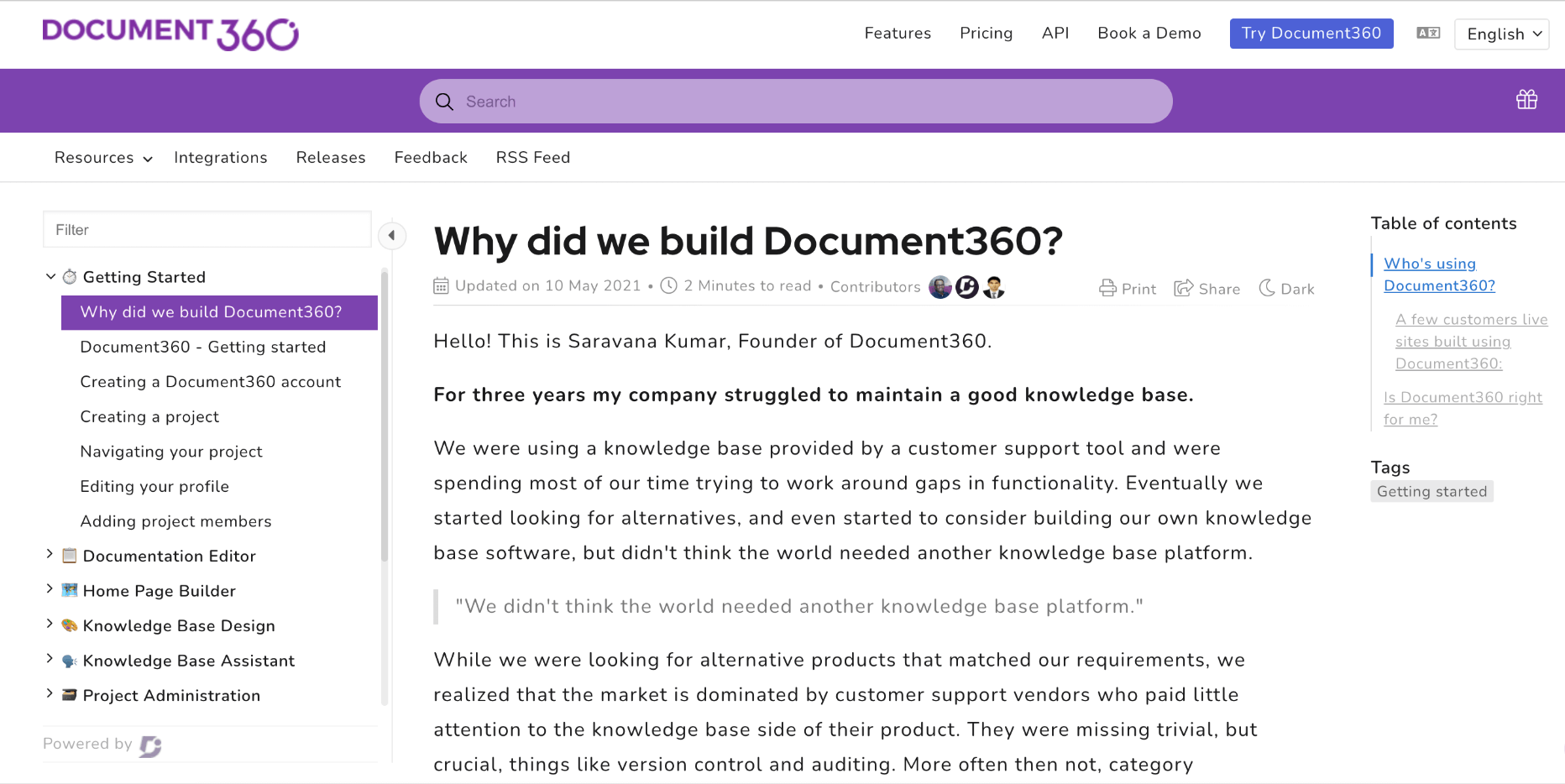
I like Document360 for its powerful real-time search engine. It provides fast, context-sensitive results, drastically reducing the time it takes for teams and users to find the necessary information. Whether it’s troubleshooting articles, setup guides, or policy documents, it delivers relevant content at the speed of need, enhancing our overall productivity and user satisfaction.
The platform’s version control and rollback capabilities ensure that updates and edits don’t lead to lost work, maintaining the integrity of our documentation over time. The ability to categorize and tag articles has also made our documentation more organized and navigable.
Moreover, Document360’s analytics suite enables deep insights into how your documentation is being used. You can see which articles are most popular, where users spend the most time, and what search terms they use. These analytics have been crucial in guiding our content strategy, helping us identify gaps in our documentation and areas for improvement.
What you will like:
- Scalable platform that grows with your team and documentation needs
- Comprehensive analytics to gauge user engagement and content effectiveness
- Powerful search functionality that enhances user experience
What you may not like:
- The initial setup can be time-consuming, given its range of features and customizations
- Pricing can be on the higher side for smaller teams or startups
Pricing:
A free plan is available. Paid plan starts at $149/project/month.
Read More: 10 Best Project Documentation Software & Tools
4. HelpNDoc – Best for Easy Multi-Format Publishing
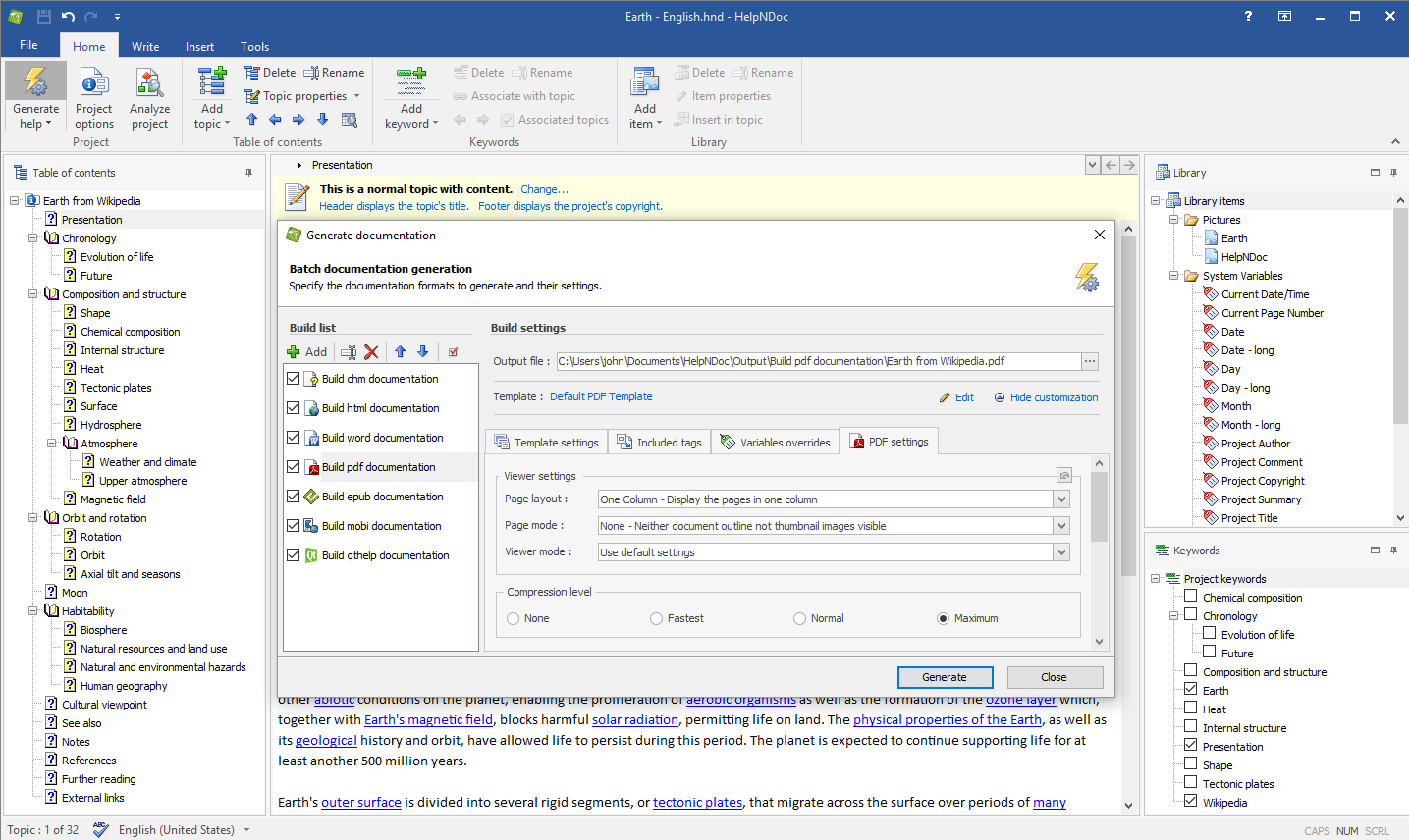
From HTML for our online help center, PDFs for downloadable guides, and even ePub formats for mobile viewing, HelpNDoc handles it all effortlessly. This versatility ensures our documentation is accessible across various platforms and devices, catering to the diverse preferences of our users.
The user interface is remarkably intuitive, allowing teams to focus on content creation rather than grappling with complex software mechanics. HelpNDoc’s built-in templates and themes have also been a boon, enabling us to maintain consistency in our documentation’s look and feel without extensive customization work.
One of the most compelling features of HelpNDoc is its library management system, which lets us efficiently organize and reuse multimedia content like images, videos, and documents. This streamlines the documentation process and ensures that our content is rich and engaging, making complex IT concepts easier to understand for our users.
What you will like:
- Ability to publish in multiple formats without additional formatting or tools
- Integrated content library to manage and reuse media and snippets efficiently
- Template-driven documentation for consistency across various outputs
What you may not like:
- Focus on output formats might overshadow web-based documentation features
- The software is primarily desktop-based, which might limit collaboration
Pricing:
Paid plan starts at $106 for the standard, named license.
5. ClickHelp – Best for Comprehensive Online Documentation With Powerful SEO
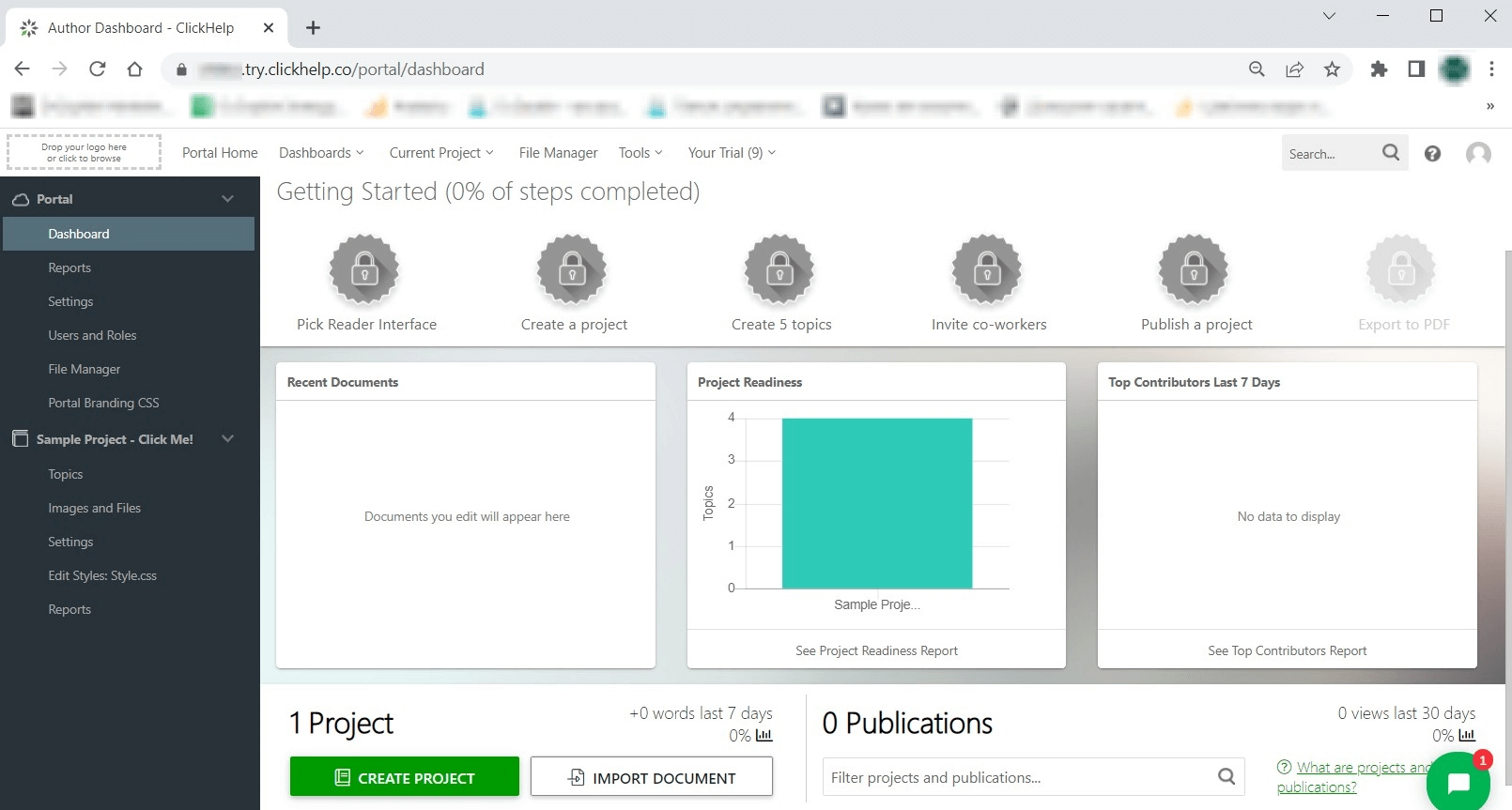
ClickHelp’s powerful SEO features have significantly increased the visibility of our help content, making it easier for users to find the information they need through search engines. This aspect is crucial for improving user engagement and reducing the workload on our IT support team by directing users to self-help resources.
It also offers multiple publishing options, enabling teams to create detailed, well-structured documentation without extensive web development skills. Its ability to handle multiple projects within a single portal has also made managing documentation for different products and services more accessible.
ClickHelp’s security and permission settings allow us to control access to sensitive information. Whether it’s internal documentation that should only be available to specific team members or public guides that need wider accessibility, it allows us to tailor content visibility according to our needs.
What you will like:
- Cloud-based platform enabling remote documentation management
- Strong SEO features ensure your documentation ranks well in search results
- Comprehensive security and feedback tools to enhance and protect your content
What you may not like:
- The wide array of features might present a steep learning curve for new users
- Cost could be a consideration for smaller teams or organizations
Pricing:
Paid plan starts at $175/month for unlimited projects.
6. KnowledgeOwl – Best for Customizable Knowledge Bases
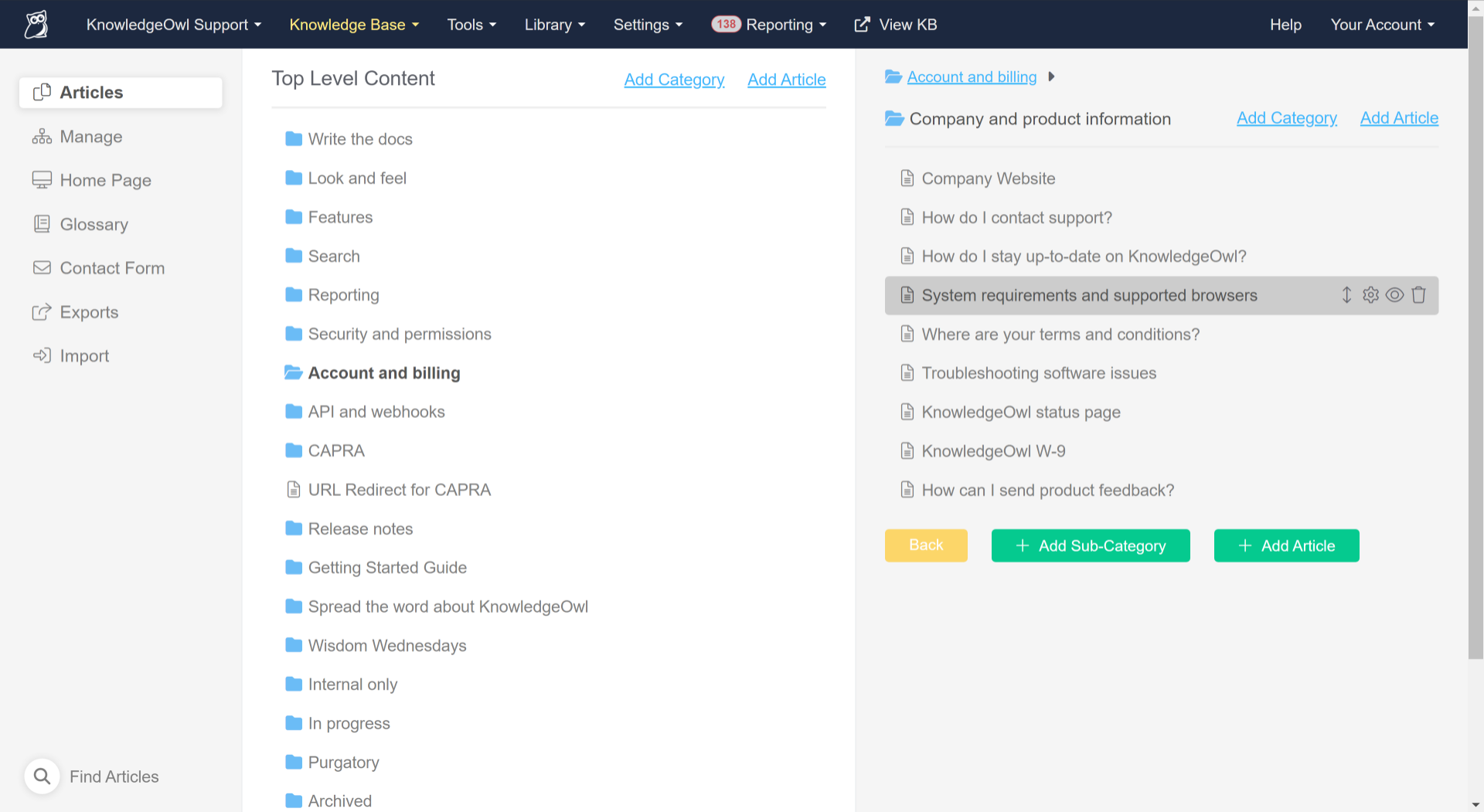
I like KnowledgeOwl for its deep customization options. It makes it easier to tailor the appearance and functionality of your knowledge base to match your company’s branding. The platform’s rich features, from custom CSS to widgets, allow us to create a unique resource center that stands out.
Its user-friendly interface makes it easy for contributors to add and update content, encouraging a collaborative approach to knowledge management. KnowledgeOwl’s robust search capabilities ensure that users can quickly find the information they need, improving overall satisfaction and self-service success rates.
The platform’s analytics tools help teams understand user behavior and content performance. By analyzing which articles are most viewed and which search terms are most used, you can continually refine your knowledge base to meet the needs of our users better, ensuring that our IT documentation remains relevant and valuable.
What you will like:
- Intuitive design and ease of use for content creators of all skill levels
- Customization options to align the knowledge base with your brand
- Comprehensive features supporting content accuracy and user feedback
What you may not like:
- While user-friendly, some advanced customization options may require a learning curve
- Pricing may be steep for smaller organizations or startups
Pricing:
KnowledgeOwl offers one plan at $100/month.
7. Confluence – Best for Team Collaboration on Documentation
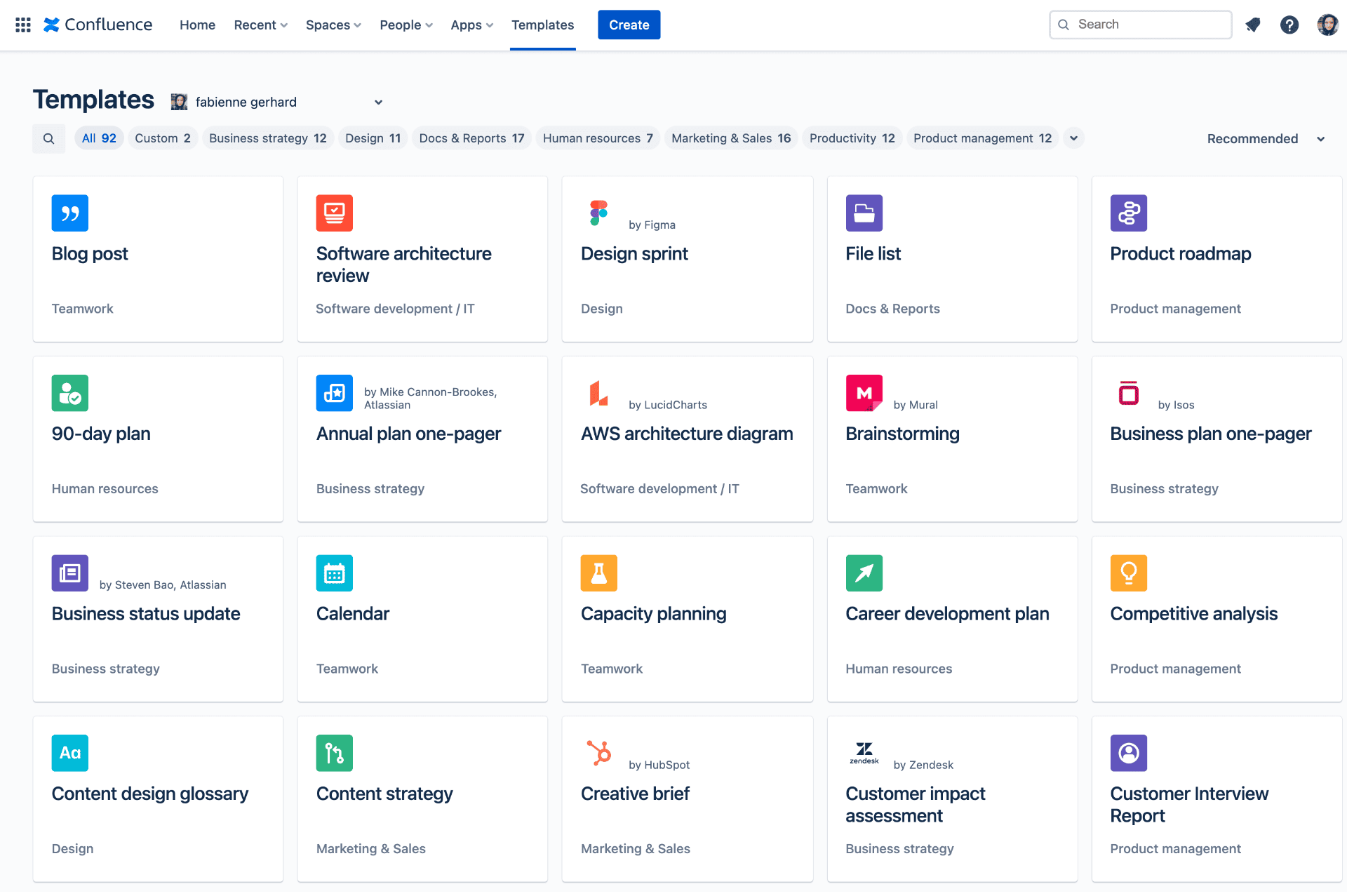
Confluence’s seamless integration with other Atlassian products, like Jira, enhances your project management and documentation efforts, allowing for a cohesive workflow. Its rich text editor and diverse range of macros enable you to create dynamic content that includes code snippets, tables, and more, making our documentation comprehensive and engaging.
It allows team members to comment, edit, and review content in real-time, significantly improving your documentation’s quality and accuracy. This collective effort ensures that your IT knowledge base is a living document, continually updated and refined by the insights and experiences of our entire team.
Confluence’s space and page permissions allow managing who can view or contribute to different parts of your documentation. This level of control is essential for maintaining the security of sensitive information while promoting knowledge sharing and collaboration within the appropriate teams and projects.
What you will like:
- Strong integration with Atlassian’s suite, offering a cohesive ecosystem for project documentation management
- Extensive collaboration features facilitating team-based documentation efforts
- A wide array of templates speeding up the content creation process
What you may not like:
- The platform’s extensive features can be overwhelming for new users
- Primarily suited for teams already within the Atlassian ecosystem
Pricing:
A free plan is available for up to 10 users. Paid plan starts at $6.05/user/month.
8. Notion – Best for Versatile Documentation & Project Management
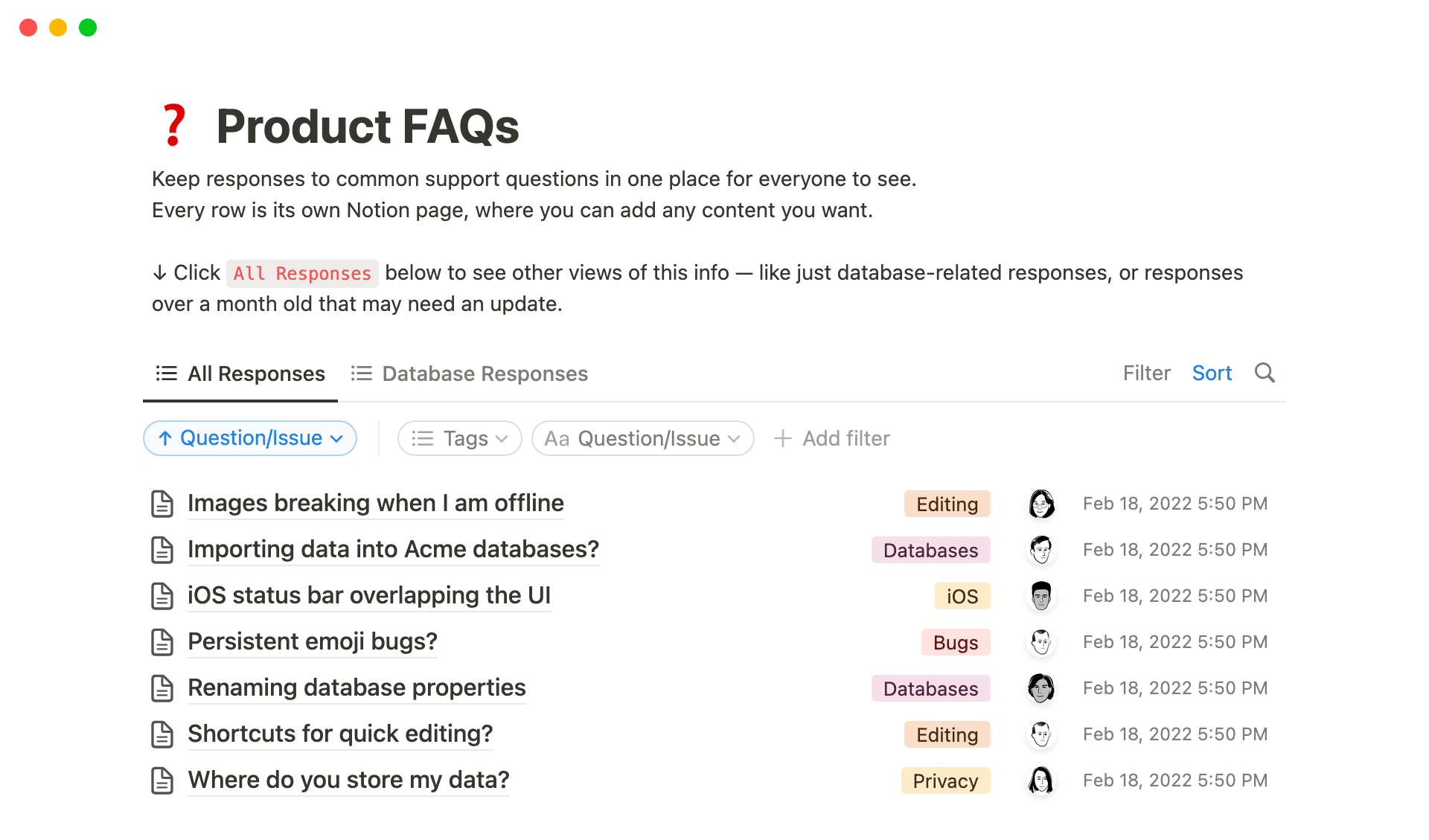
Notion’s versatility makes it ideal for managing documentation and your projects and processes. Its drag-and-drop interface simplifies content organization, while its extensive template library jumpstarts the creation of detailed documents.
What sets Notion apart is its flexibility; you can customize almost every aspect of our workspace to fit our team’s workflow and documentation style. This adaptability has been vital in creating a centralized knowledge hub tailored to your needs. Collaborative features like real-time editing and sharing enable a culture of openness and teamwork.
The integration capabilities of Notion with other tools enhance its utility, making it a central repository for all your IT documentation needs. However, the platform’s simplicity does not come at the cost of depth. Notion supports complex hierarchical structures for organizing documentation, making navigating and managing large volumes of information accessible.
What you will like:
- Highly customizable and flexible platform for various documentation needs
- User-friendly interface with drag-and-drop functionality for ease of use
- Strong collaboration tools supporting team engagement and knowledge sharing
What you may not like:
- The platform’s wide range of features might require time to fully master
- Some users may find the lack of a dedicated desktop app limiting
Pricing:
A free plan is available. Paid plan starts at $8/user/month.
9. Read the Docs – Best for Open Source Project Documentation
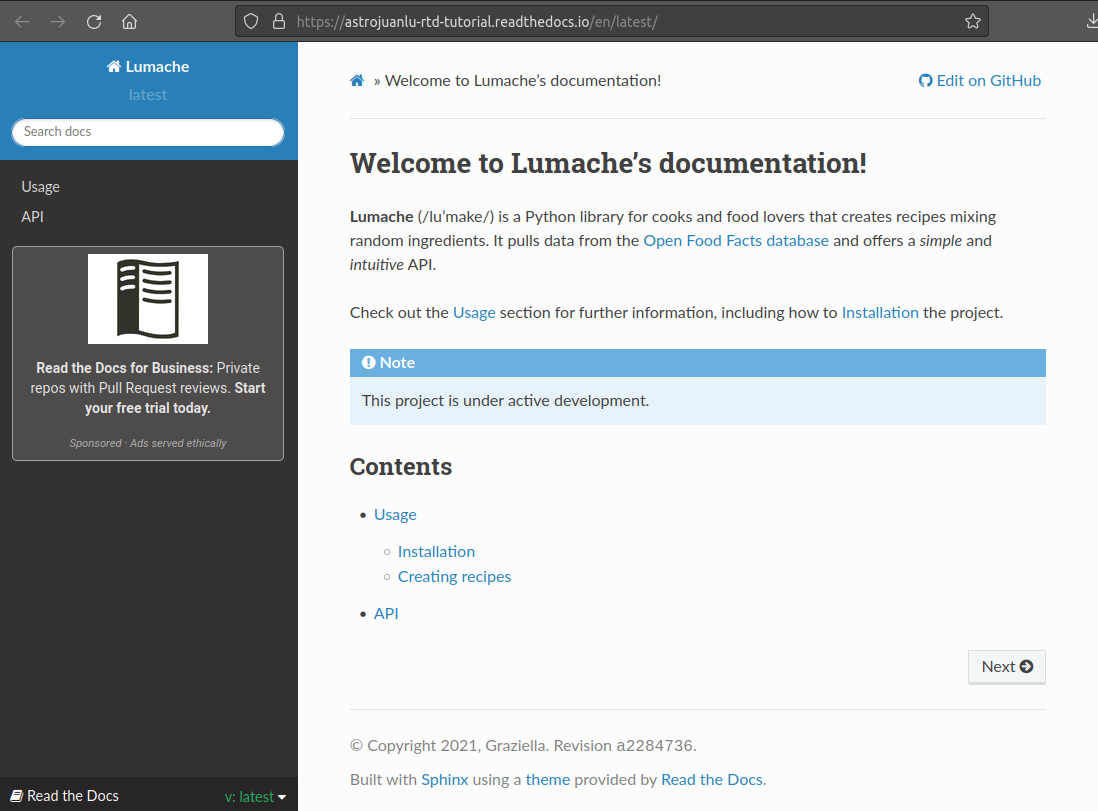
We have used Read The Docs to document our open-source projects. It provided a seamless way to create, host, and update our documentation alongside our code. Its integration with version control systems like GitHub ensures that our documentation is always in sync with our latest codebase, automating the documentation process and reducing manual effort.
The platform specializes in technical documentation, supporting Sphinx and MkDocs for writing content. This compatibility allows us to leverage powerful formatting and organizational tools designed specifically to create software documentation. It also offers versioning capabilities, making it easy for users to access documentation for different versions of our software, enhancing user experience and support.
It also offers free hosting for open-source projects, aligning with our collaboration and sharing ethos. This feature and its robust documentation capabilities make it an invaluable resource for our open-source initiatives, encouraging community contributions and facilitating easier project onboarding.
What you will like:
- Automated documentation processes closely integrated with code changes
- Strong support for open-source projects with free hosting
- Compatibility with Sphinx and MkDocs for versatile documentation writing
What you may not like:
- Primarily tailored for technical users and open-source projects, which might not suit all organizations
- The platform’s focus on integration with code repositories may present a learning curve for non-developers
Pricing:
Read The Docs offers free hosting for open-source projects. Paid plan starts at $5/month to remove ads from your documentation.
10. Sphinx – Best for Detailed Technical Documentation
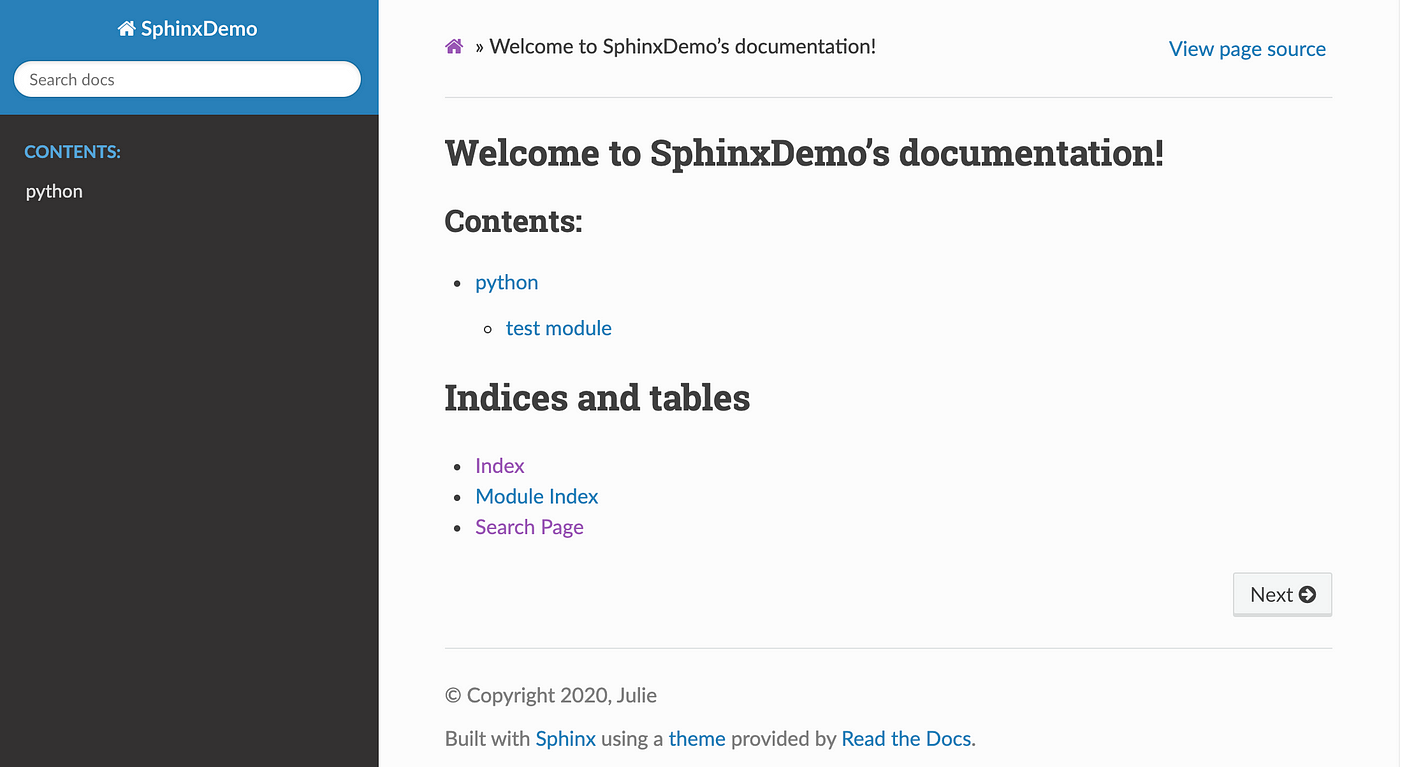
Sphinx is great for creating detailed technical documentation for your software projects. Its strength is producing clean, structured, readable, visually appealing documentation. It uses reStructuredText as its markup language, offering extensive formatting options and the ability to include programming code with syntax highlighting.
One of the critical features of Sphinx is its extensibility; through extensions, you can add functionality like automatic documentation generation from code comments, link checking, and internationalization. This flexibility allows us to tailor our documentation process to our needs, improving efficiency and coherence across our documentation efforts.
Sphinx’s support for multiple output formats, like HTML, PDF, and ePub, ensures your documentation is accessible on various devices and platforms. This versatility, combined with Sphinx’s robust indexing and search capabilities, makes your technical documentation easily navigable and user-friendly.
What you will like:
- Flexibility in output formats catering to various documentation needs
- Advanced formatting and organization capabilities through reStructuredText
- Extensibility with plugins and themes for customized documentation
What you may not like:
- The learning curve associated with mastering reStructuredText and Sphinx’s advanced features
- Primarily suited for technical documentation, which may not be ideal for all types of content
Pricing:
Sphinx is an open-source tool available for free, making it an attractive option for projects of all sizes.
Evaluation & Selection Criteria
The evaluation of products or tools chosen for this article follows an unbiased, systematic approach that ensures a fair, insightful, and well-rounded review. This method employs six key factors:
- User Reviews / Ratings: Direct user experiences, including ratings and feedback from reputable sites. This feedback is critical in understanding overall satisfaction and potential problems.
- Essential Features & Functionality: The value of a product is ascertained by its core features and overall functionality. Through an in-depth exploration of these aspects, the practical usefulness and effectiveness of the tools are carefully evaluated.
- Ease of Use: The user-friendliness of a product or service is assessed, focusing on the design, interface, and navigation. This ensures a positive experience for users of all levels of expertise.
- Customer Support: The quality of customer support is examined, considering its efficiency and how well it supports users in different phases – setting up, addressing concerns, and resolving operational issues.
- Value for Money: Value for money is evaluated by comparing the quality, performance, and features. The goal is to help the reader understand whether they would be getting their money’s worth.
- Personal Experience/Expert’s Opinion or Favorites: This part of the evaluation criteria draws insightful observations from the writer’s personal experience and the opinions of industry experts.
Factors to Consider While Choosing IT Documentation Software
Choosing the ideal IT documentation software is a vital decision that affects how effectively your organization can manage and share knowledge.
Here are vital factors to consider:
Ease of Use
The tool should have an intuitive interface that makes it easy for users of all technical levels to create, edit, and find documentation.
A steep learning curve can hinder adoption and productivity, so look for software that offers a straightforward user experience, including easy navigation and simple content creation processes.
Customization & Flexibility
Every business has unique needs, so the ability to customize the documentation site and software to fit your specific requirements is crucial.
This includes custom templates, branding options, and the flexibility to structure your documentation library in a way that makes sense for your team and the end-users. The more you tailor the software, the better it will serve your organization.
Integration Capabilities
Consider how well the software integrates with other tools and platforms your team uses.
Seamless integration with project management tools, CRM systems, and customer support software can streamline workflows and reduce the need for manual data entry or switching between applications.
Effective integration enhances efficiency and ensures consistency across platforms.
Collaboration Features
Documentation is often a collaborative effort. Look for a tool that supports real-time collaboration, allowing multiple team members to work on documents simultaneously, leave comments, and track changes.
Collaboration on knowledge articles ensures that knowledge is shared and updated efficiently, keeping everyone on the same page.
Scalability
The software should be able to grow with your business. As your team and documentation needs expand, the software should continue to meet your requirements without performance degradation.
Consider the software’s capacity for handling a large number of documents, users, and simultaneous accesses.
Search Functionality
Robust search functionality is essential for users to quickly find the necessary information.
The software should offer advanced search options, like filtering by tags, categories, or custom fields, to make locating specific pieces of documentation as effortless as possible.
Security & Permissions
Given the sensitive nature of IT documentation, the software must have robust security measures in place, including data encryption and secure access controls.
Granular permission settings also allow you to control who can view, edit, or manage specific documents, ensuring that sensitive information is protected and only accessible to authorized individuals.
Support & Training
Quality support from the software provider is crucial for resolving any issues. Look for providers that offer comprehensive training resources, responsive customer support, and a helpful user community.
Good support ensures that any challenges can be quickly overcome, minimizing disruptions to your documentation processes.
Analytics & Reporting
Insightful user engagement analytics and reporting capabilities can help you understand how your documentation is used, identify popular content, and identify areas where your documentation may be lacking.
These insights can drive continuous improvement, ensuring your IT documentation remains relevant and valuable.
Choosing the right IT documentation platform involves carefully weighing these factors against your organization’s needs and priorities.
Doing so allows you to select a tool that streamlines documentation management, supports your team’s productivity, and enhances overall knowledge sharing within your organization.
Considering the relevancy of features for creating extensive IT documentation software, ProProfs Knowledge Base stands out for its ease of use, versatile AI-powered WYSIWYG editor, and collaborative features like internal comments and user reports.
Do opt for a personalized demo before finalizing any tool. All the best!
FREE. All Features. FOREVER!
Try our Forever FREE account with all premium features!








